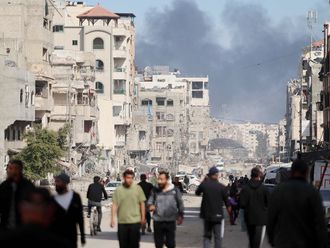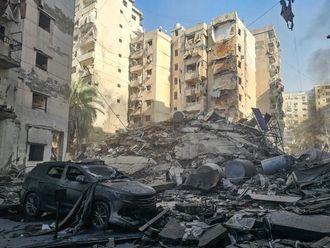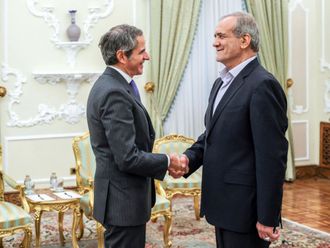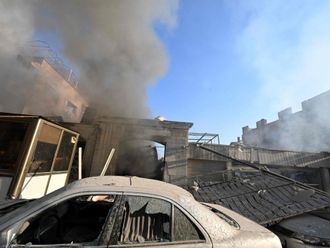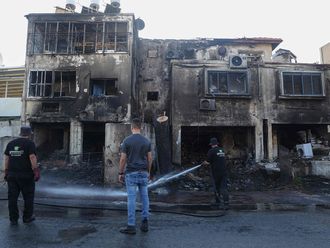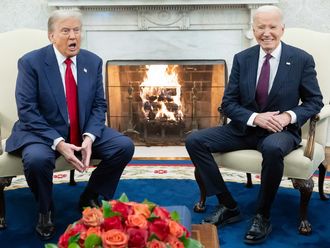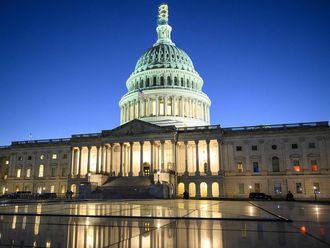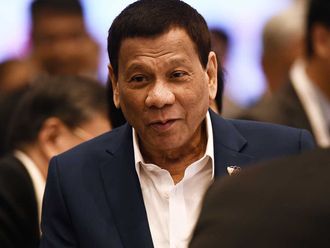
BEIRUT/JERUSALEM: Israeli warplanes struck Lebanon’s Bekaa Valley on Monday, killing at least two Hezbollah members in its deepest attack into Lebanese territory since hostilities erupted with the Iran-backed militant group last October, sources in Lebanon said.
The Israeli army said its fighter jets had struck Hezbollah air defences in the Bekaa Valley in response to the downing of an Israeli drone, which the Lebanese group said it had shot down with a surface-to-air missile.
The incidents marked an escalation of hostilities fought in parallel to the conflict in Gaza, heightening the risks of further escalation between heavily armed adversaries that last went to war in 2006.
The Israeli strikes hit a region near the Syrian border which is a political stronghold of the Shiite Hezbollah, some 18km (11 miles) from the city of Baalbek, which is known for its ancient ruins.
The sources said Israel had carried out simultaneous strikes in the area. A Lebanese security source and a source familiar with the matter said two Hezbollah members had been killed.
Lebanese television station Al Jadeed broadcast images of plumes of smoke rising from the area.
Hezbollah politician Hassan Fadlallah said Israel had widened its strikes by hitting Baalbek and other areas, and was seeking to “compensate” for the downing of its drone.
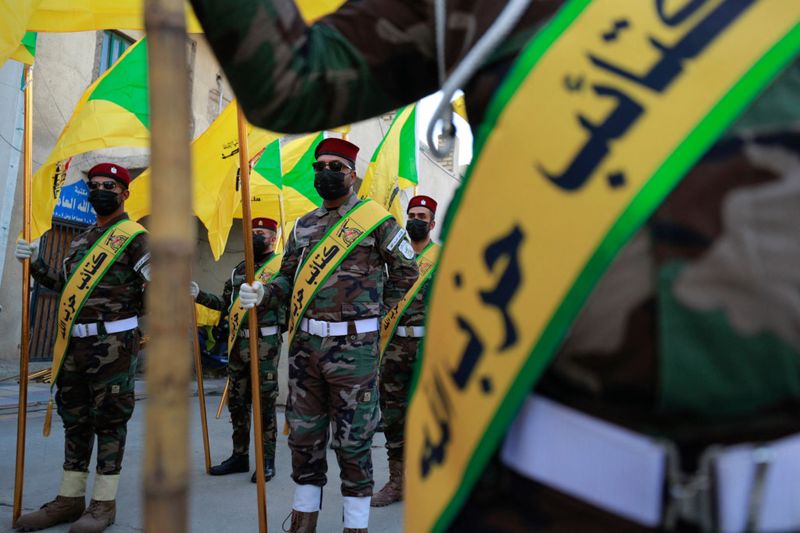
The group has risen from a shadowy faction to a heavily armed force with major sway over the Lebanese state. The US, some Western nations and others deem it a terrorist group.
HOW POWERFUL IS HEZBOLLAH’S MILITARY?
While other groups disarmed after Lebanon’s civil war, Hezbollah kept its weapons to fight Israeli forces that were occupying the predominantly Shiite south of the country. Years of guerrilla warfare led Israel to withdraw in 2000.
Hezbollah demonstrated its military advances in 2006 during a five-week war with Israel, which erupted after it crossed into Israel, kidnapping two soldiers and killing others.
Hezbollah fired thousands of rockets into Israel during the conflict, in which 1,200 people were killed in Lebanon, mostly civilians, and 158 Israelis were killed, most of them soldiers.
Hezbollah’s military power grew after it deployed into Syria to help President Bashar al-Assad fight mostly Sunni Muslim rebels. Hezbollah says its forces, which have precision rockets, can hit all parts of Israel.
WHAT’S HEZBOLLAH’S ROLE IN THE ISRAEL-HAMAS CONFLICT SO FAR? Hezbollah has deep ties to Hamas, which controls Gaza, and Islamic Jihad, another Palestinian faction backed by Iran.
Since Oct. 7, Hezbollah has engaged in increasingly heavy exchanges of cross-border fire with Israel. Hamas and Islamic Jihad, which both have a presence in Lebanon, have mounted attacks on Israel from Lebanon for the first time, including an Oct. 10 cross-border infiltration into Israel by Islamic Jihad.
Israeli Prime Minister Benjamin Netanyahu said on Oct. 22 that, if Hezbollah opened a war front with Israel, it would lead to counter-strikes of “unimaginable” magnitude on Lebanon.
WHAT REGIONAL SWAY DOES HEZBOLLAH HAVE?
The Gaza conflict has rippled across the Middle East, where Hezbollah has inspired and supported other Iranian-backed groups.
In February Washington staged strikes against Iran-aligned groups in Irag, Syria and Yemen in retaliation for a deadly attack on US troops in Jordan.
Saudi Arabia says Hezbollah has also fought in support of the Iran-allied Houthis in Yemen. Hezbollah denies this.
WHAT IS HEZBOLLAH’S ROLE IN LEBANON?
Hezbollah’s influence is underpinned by its sophisticated arsenal and the support of many Lebanese Shi’ites who say the group defends Lebanon from Israel.
Lebanese parties opposed to Hezbollah say the group has undermined the state and accuse it of unilaterally dragging Lebanon into armed conflicts. Hezbollah has ministers in government and lawmakers in parliament.
It entered Lebanese politics more prominently in 2005 after Syria withdrew forces from Lebanon following the killing of former prime minister Rafik Hariri.
A UN-backed court convicted three Hezbollah members in absentia over the assassination. Hezbollah denies any role, describing the court as a tool of its enemies.
In 2008, a power struggle between Hezbollah and its Lebanese political adversaries spiralled into a brief conflict. Hezbollah fighters took over parts of Beirut after the government vowed to take action against the group’s military communications network.
In 2018 Hezbollah and its allies won a parliamentary majority. This majority was lost in 2022, but the group has continued to exercise major political sway.
-- Reuters
“Its aggression on Baalbek or any other areas will not remain without response,” he said in televised remarks delivered at the funeral of a Hezbollah fighter killed in recent days.
An Israeli airstrike also hit a car in southern Lebanon, Hezbollah’s Al Manar TV reported. A security source in Lebanon said at least one person had been killed.
Hezbollah’s leader Hassan Nasrallah had boasted that the group has 100,000 fighters, though other estimates put its troop strength at less than half that. Israel wants Hezbollah to withdraw its elite Radwan Force from the border so tens of thousands Israelis displaced from northern towns and villages can return home.
Hezbollah holds a vast arsenal of mostly small, portable and unguided surface-to-surface artillery rockets, according to the Center for Strategic and International Studies, a Washington think tank. The US and Israel estimate Hezbollah and other militant groups in Lebanon have some 150,000 missiles and rockets. Hezbollah also has been working on precision-guided missiles.
Hezbollah has previously launched drones into Israel and in 2006, hit an Israeli warship with a surface-to-sea missile. Its forces also have assault rifles, heavy machine guns, rocket-propelled grenades, roadside bombs and other weaponry.
During the current conflict, Hezbollah has frequently used Russian-made portable anti-tank Kornet missiles. More rarely, it has launched Burkan rockets that, according to Nasrallah, can carry a warhead that weighs between 300 kilos (660 pounds) and 500 kilos (1,100 pounds).
In recent weeks, Hezbollah has introduced new weapons including a surface-to-surface missile with a range of 10km (6 miles) and a warhead weighing 50 kilos (110 pounds).
WHAT ARE ISRAEL’S MILITARY CAPABILITIES?
Israel’s military has long been supported by the United States, with $3.3 billion in annual funding, plus $500 million toward missile defence technology.
Israel is one of the best-armed nations in the wider Middle East. Its air force includes the advanced American F-35 fighter jet, missile defence batteries including the American-made Patriot, the Iron Dome rocket-defence system and a pair of missile-defence systems developed with the US, the Arrow and David’s Sling.
Israel has armoured personnel carriers and tanks, and a fleet of drones and other technology available to support any street-to-street battles.
Israel has some 170,000 troops typically on active duty and has called up some 360,000 reservists for the war — three-fourths of its estimated capacity, according to the International Institute for Strategic Studies, a British think tank. With the war now in its fifth month, many of those reservists have returned home.
Israel has also long maintained an undeclared nuclear weapons programme.
The Israeli military said it would “continue operating to defend the State of Israel from the threat of Hezbollah terrorist organization, including in aerial operations above Lebanese territory”.
Hezbollah has been waging a campaign of attacks on targets at the border with Israel since the Oct. 7 raid from the Gaza Strip by its Palestinian ally Hamas. Hezbollah describes it as an effort to support Palestinians under Israeli fire in Gaza.
Why is Israel attacking Hezbollah?
The hostilities have largely played out in areas near the Lebanese-Israeli border, but last week widened when Israel struck an area just south of the coastal city of Sidon.
Israeli Defence Minister Yoav Gallant indicated on Sunday that Israel planned to increase attacks on Hezbollah in the event of a possible ceasefire in the Gaza conflict.
“If a temporary pause is reached in Gaza, we will increase the fire in the north separately, and will continue until the full withdrawal of Hezbollah [from the border] and the return of Israeli citizens to their homes,” he said.
The violence has uprooted tens of thousands of people on both sides of the border.
Hezbollah said earlier on Monday it had shot down an Israeli Hermes 450 drone over Lebanese territory with a surface-to-air missile.
The Israeli military said two missile launches had targeted an Israeli Air Force unmanned aerial vehicle operating over Lebanon. The first, it said, was intercepted by Israel’s “David’s Sling” Aerial Defense System but the drone “fell inside Lebanese territory” after a second launch.
Israeli strikes since October have killed some 50 civilians in Lebanon, in addition to some 200 Hezbollah fighters.
Attacks from Lebanon into Israel have killed a dozen Israeli soldiers troops and five civilians.


